Washington (1837) facts for kids

USS Washington at left and La Amistad
|
|
Quick facts for kids History |
|
|---|---|
| Name | Washington |
| Namesake | Peter G. Washington |
| Ordered | 6 July 1837 |
| Christened | 1 August 1837 |
| Completed | 1837. |
| Commissioned | before November 1837 |
| Decommissioned | after June 1861 |
| Fate |
|
| General characteristics | |
| Displacement | 190 tons |
| Length | 91 ft 2 in (27.79 m) |
| Beam | 21 ft 2 in (6.45 m) |
| Propulsion | Sail. |
| Sail plan | Topsail schooner; re-rigged as a brig in 1838 |
| Armament | 10 guns (pre-1860); 1 × 42-pound pivot (1860) |
The Washington was a special kind of ship called a revenue cutter. These ships helped the government collect taxes on goods and stop smuggling. Washington served both the United States Revenue Cutter Service and the United States Navy. She became famous for finding and capturing the ship La Amistad in 1839. This happened after enslaved people on La Amistad took control of the ship in a mutiny.
Contents
The Ship's Beginning
The Washington was the second ship to have this name in the Navy. It was named after Peter G. Washington, who held important jobs in the government. He worked in the Treasury Department and as a Postmaster General. The ship was ordered on July 6, 1837, and named on August 1, 1837.
Washington was built very quickly. By November 1837, she was ready for duty. Her first trip started on December 18, sailing along the eastern coast of the United States. For several years, she sailed in the winter to patrol the seas. In the summers of 1838 and 1839, she helped map the ocean floor. During this time, the ship was changed from a schooner to a brig in Baltimore, Maryland.
Finding La Amistad
In the summer of 1839, Washington was mapping the waters near New York. On August 26, 1839, the crew saw a "suspicious-looking vessel" anchored nearby. The commander, Lieutenant Thomas R. Gedney, sent a team to check it out.
They found the ship was a schooner called La Amistad, from Havana, Cuba. It had left Africa a few months earlier, carrying two white passengers and 54 enslaved people. They were headed to Guanaja, Cuba. Four days into the journey, the enslaved people rebelled. They took control of the ship and killed the captain and his crew. They kept the two passengers alive to help them sail back to Africa. For two months, La Amistad drifted at sea, and nine of the enslaved people died.
Working for the Coast Survey
On April 23, 1840, Washington was moved to the Coast Survey. This group was the early version of today's National Oceanic and Atmospheric Administration (NOAA). For the next 12 years, the ship worked for the Navy. She continued to survey and map the eastern coast of the United States.
Life at sea was not always calm. In 1846, while in Chesapeake Bay, Washington was hit by a terrible storm. The storm broke her masts, but the ship stayed afloat. She managed to get back to port, but 11 men were lost overboard, including the ship's commander, Lieutenant George M. Bache.
Service in the Mexican-American War
When the Mexican–American War began, Washington joined the forces of Commodore Matthew C. Perry. Under the command of Lieutenant Commander Samuel Phillips Lee, Washington helped capture Tabasco on June 16, 1847.
The ship also sent six officers and 30 men to join a larger landing force. This force attacked and captured the Mexican stronghold at Tuxpan.
Later Years and Fate
On May 18, 1852, Washington returned to the Treasury Department. She had major repairs in New York that lasted until early winter. The repairs finished on December 9, 1852. For the next six years, Washington stayed and worked around the New York area.
In January 1854, Washington helped search for the missing steamer San Francisco. Several other revenue cutters also joined the search. Sadly, none of the ships found San Francisco.
In the spring of 1859, Washington was ordered to the Gulf of Mexico. She arrived at Southwest Pass, Louisiana, and stayed there until 1861. The American Civil War began, and the ship was in New Orleans. Authorities from Louisiana took control of her after the state left the Union on January 31, 1861.
Not much is known about the ship after this. In June 1861, Commodore David Dixon Porter reported that Washington was being prepared for sea in New Orleans.
On April 25, 1862, Confederate forces scuttled (sank on purpose) Washington at the docks in New Orleans. They did this to stop the ship from being captured by the squadron of Flag Officer David Glasgow Farragut, which arrived in New Orleans that day.


